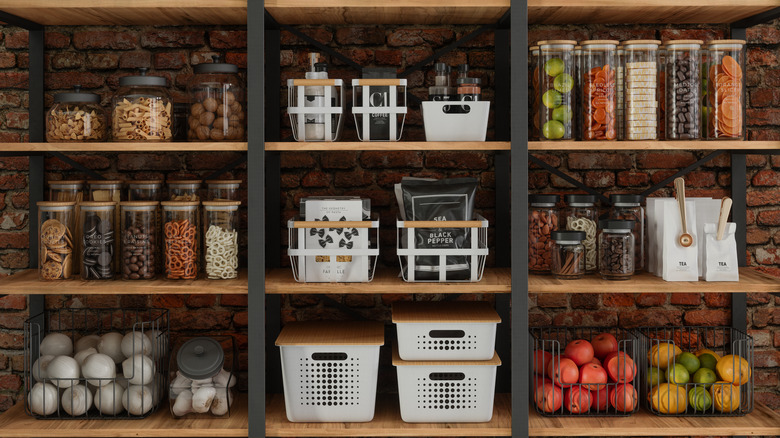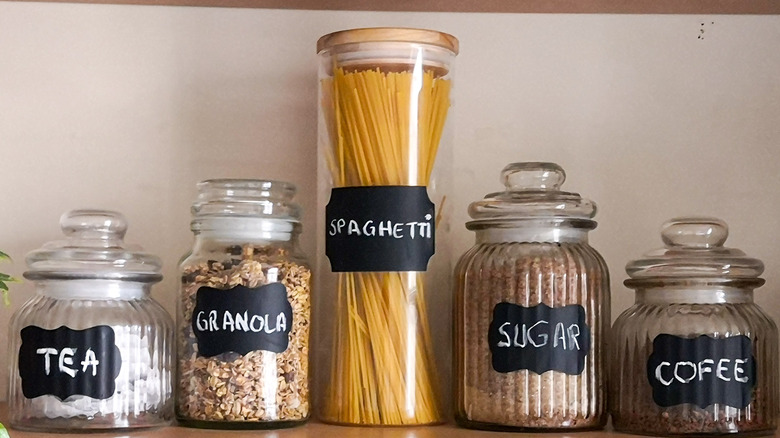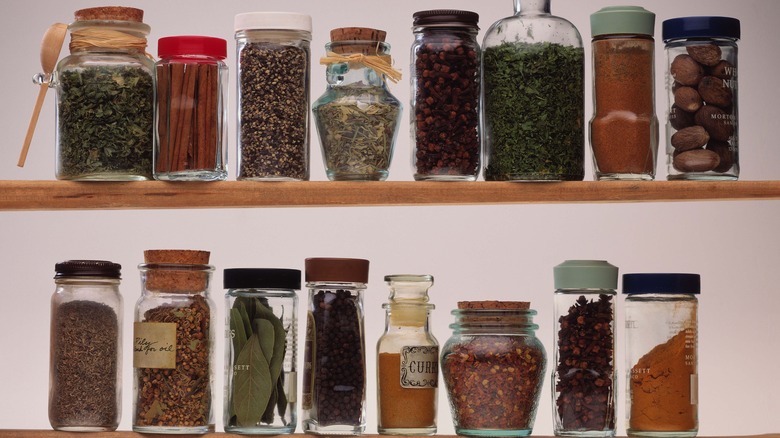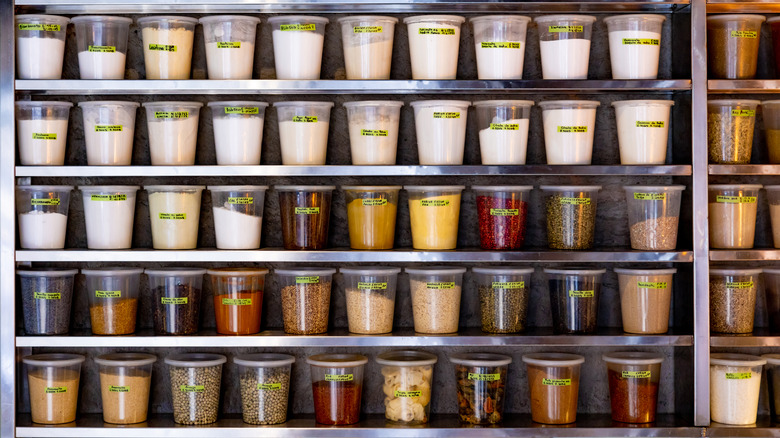When To Decant Pantry Staples Vs. Leave Them In The Package
An organized pantry makes it easier to find what you're looking for and see what you're out of. Decreased clutter is not just more user-friendly and pleasing to the eye. An organized layout of well-sealed containers can help prevent spills, pests, and spoilage. Decanting pantry staples – transferring goods from their original packaging into clear and labeled containers – can be the answer. However, this doesn't mean you should run out and buy huge sets of plastic containers and dozens of tiny glass jars. Decanting well actually takes a fair amount of up-front organization to reap the benefits, and part of that planning means figuring out what items should not be decanted.
In general, items used in one sitting should be left in their original packaging. Liquids and spices that already come in clear glass or plastic containers can also be left as is. Products that quickly go stale, come in large bags, or are only used a little bit at a time are good candidates for decanting.
To be or not to be, or when to decant
Start by taking stock of what you like to have on hand, how much of it you typically buy, and what your habits of use are. For example, dried pasta is great to decant if you live alone and only cook a portion of the package at a time, but should be left in its original packaging if you cook for a family that eats a pound of spaghetti for dinner.
Baking ingredients like flour, sugar, oats, cocoa powder, and baking soda can almost always be decanted as the packaging is not usually resealable, and you typically use them over a longer period of time. Rice, dried beans, and other grains that can quickly attract pests are good candidates. Nuts, seeds, and snacks bought in the bulk aisle, as well as bagged potato chips and popcorn, can all be moved out of plastic bags into containers to prevent spoilage and make storing much easier. Items that are often bagged and then boxed, like cereal, panko breadcrumbs, or crackers, are bulky and hard to keep tabs on, and can also be decanted.
Keep in mind however that decanting decisions really depend on the usage habits that you already have and will be different for everyone. The shift to decanting should mold naturally to your existing patterns. Otherwise, it can just be cumbersome and unsustainable.
When to just leave it be
Sauces, liquids, spices, and anything that already comes in a clear glass or plastic container need not be moved into another clear glass or plastic container. This is just creating more work. As pretty as those rows of identical tiny spice jars look, it's just that. Pretty. If your spices (or vinegars or soy sauce) are on display and you're after a more aesthetic vibe, then by all means, decant away. However, decanting spices often means that you lose some of the product along the way and is more than likely unnecessary.
The exception to this would be spices that are purchased in bulk bags which should definitely be moved into air-tight containers both for maintaining freshness and ease of access. Cooking oils are another exception. Pulling out a large jug of cooking oil is unwieldy, so decanting into a bottle with a pour spout or a squeeze bottle are great options.
Additionally, if you live in a snacky household where chips, pretzels, cookies, and crackers are eaten very quickly, these items may be better off left in the original packaging and just secured with a bag clip or rubber band. In other homes, these might be great items to decant. Again, it really depends on the habits of you and your family.
How to pick your organizational items
Knowing your pantry patterns will clarify which containers you need to purchase, and also help you decide which items are best kept in their original packaging. Blogger Abby Lawson suggests making a list of everything you wish to decant and then use the volume and dimensions measurements on the package to determine what size containers you will need. Measure pantry shelves to determine how everything will fit.
The choice of plastic versus glass depends on personal preference. Mason jars are easy to clean and pretty to look at, but the rounded shape can make them less spatially efficient. Rectangular, air-tight, plastic, pop containers are ideal for organizing in ascending size. Take a hint from professional kitchens and try Cambro containers. They come in a wide range of sizes, are easily stackable, and have measurement markings. Chefs also love plastic pint and quart containers, the kind that take-out soups are often packed in. Baskets and clear lidless bins can help with the organization of items that are left in the original packaging, canned goods, and backstock.
Whether you use a label maker, dry-erase labels, or a classic roll of masking tape and a permanent marker, labeling is a must. Include the name of the product and the date it was opened, or label bins of non-decanted products by category. With some legwork, a well-organized pantry is right around the corner, making everything from cooking to snacking to grocery shopping a little easier!




